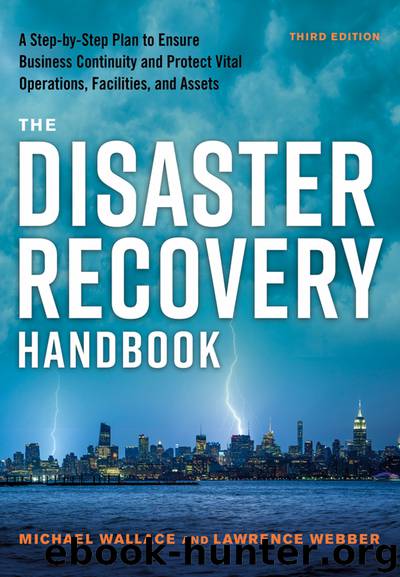The Disaster Recovery Handbook by Michael Wallace & Lawrence Webber

Author:Michael Wallace & Lawrence Webber
Language: eng
Format: epub
Publisher: AMACOM
Published: 2017-03-17T04:00:00+00:00
The ISO 22301 standard consists of 12 clauses. The first three provide the introduction and explain terms. The other nine clauses are the requirements. They work together as a whole and at times seem to repeat the same ideas. Still, the specific requirements are written so that they are different. Here are the main requirement clauses and actions that you should take.
Clause 4: Company’s Context with Its Many Stakeholders
Clause 4 requires that the company understand the needs of all critical stakeholders. This helps to determine the scope of the DR/BCP program. Conversations with the various stakeholders should be documented. This may include the topics/questions discussed, who attended the discussions, and stakeholder approval of what was expected.
1. Review with your legal advisers what is required to meet regulatory obligations for your company. This may be specific to your industry (e.g., banking, medical, defense). If the facility uses chemicals, then the local environmental control agencies must be involved. If you are a publicly traded company, there may be other regulatory requirements to fulfill.
2. Ask the company’s Board of Directors for their guidance for disaster recovery and business continuity planning. They may provide general requirements and hold specific guidance pending the results of the BIA and the risk assessment.
3. Together with top management, review how the DR/BCP program fits with the company’s business strategies and goals.
4. Talk to your customers to learn what they expect in a crisis. This is usually in terms of minimal service. It is not unusual for companies to assume what their customers want instead of asking them. Some organizations service a widely dispersed audience of small customers, whereas others have a few large customers who are easier to ask. The normal assumption is that customers will be sympathetic but want their orders filled correctly and in a timely manner, despite your organization’s problems.
5. Talk to employees. The company’s employees have expectations of their role in a disaster. Their concerns include maintaining an income and ensuring the company (and their employment) survives. How are they expected to help in a recovery? Ask them what they expect. If the workforce is represented by a union, then ask for their expectations and involve them throughout the program.
Download
This site does not store any files on its server. We only index and link to content provided by other sites. Please contact the content providers to delete copyright contents if any and email us, we'll remove relevant links or contents immediately.
Bad Blood by John Carreyrou(6552)
Rich Dad Poor Dad by Robert T. Kiyosaki(6403)
Principles: Life and Work by Ray Dalio(6213)
Playing to Win_ How Strategy Really Works by A.G. Lafley & Roger L. Martin(5922)
Management Strategies for the Cloud Revolution: How Cloud Computing Is Transforming Business and Why You Can't Afford to Be Left Behind by Charles Babcock(4527)
The Confidence Code by Katty Kay(4187)
Thinking in Bets by Annie Duke(4153)
American Kingpin by Nick Bilton(3757)
Delivering Happiness by Tony Hsieh(3365)
Project Animal Farm: An Accidental Journey into the Secret World of Farming and the Truth About Our Food by Sonia Faruqi(3177)
The Power of Habit by Charles Duhigg(3062)
Brotopia by Emily Chang(3001)
The Tyranny of Metrics by Jerry Z. Muller(3000)
Mastering Bitcoin: Programming the Open Blockchain by Andreas M. Antonopoulos(2981)
The Marketing Plan Handbook: Develop Big-Picture Marketing Plans for Pennies on the Dollar by Robert W. Bly(2975)
I Live in the Future & Here's How It Works by Nick Bilton(2935)
The Content Trap by Bharat Anand(2860)
Building a StoryBrand by Donald Miller(2842)
Applied Empathy by Michael Ventura(2839)
